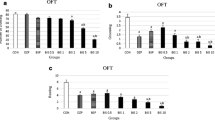Abstract
In the present study, the effects of a new anxiolytic, DN-2327, were compared to those of diazepam and buspirone in rats in the elevated plus-maze test. Two indices of anxiety were obtained in this test: the number of entries into the open arms expressed as a percentage of the total number of arm entries and the percentage of time spent on the open arms. Both a typical anxiolytic, diazepam, at 2.5, 5 and 10 mg/kg, PO and a new anxiolytic, DN-2327, at 2.5 and 5 mg/kg, PO dose-dependently increased the two indices: the percentage of time spent on the open arms and the percentage of open-arm entries. On the other hand, pentylenetetrazol (PTZ) at 10 and 20 mg/kg, IP decreased the two indices dose dependently as did yohimbine at 1.5 and 3 mg/kg, IP. DN-2327 at 2.5 and 5 mg/kg, PO and diazepam at 5 and 10 mg/kg, PO dose dependently and significantly increased the two indices that were suppressed following administration of PTZ at 10 mg/kg, IP. The effects of both DN-2327, 5 mg/kg, PO, and diazepam, 10 mg/kg, PO, on the two indices were significantly antagonized by the benzodiazepine (BZD) receptor antagonist flumazenil, 20 mg/kg, IP. Buspirone (2.5–20 mg/kg, PO) did not affect either of the two responses but dose dependently decreased the number of rearings, although in the Vogel conflict test, the anti-conflict activity of buspirone was equipotent to that of diazepam and DN-2327 at the minimum effective dose (10 mg/kg, PO) of each drug. In conclusion, the present experiment revealed that the anxiolytic effect of DN-2327 in this test was clear, whereas buspirone showed no apparent effect.
Similar content being viewed by others
References
Broadhurst PL (1957) Determinants of emotionality in the rat. 1. Situational factors. Br J Psychol 48:1–12
Charney DS, Heninger GR, Redmond DE (1983) Yohimbine-induced anxiety and increased noradrenergic function in humans: effects of diazepam and clonidine. Life Sci 33:19–29
Chopin P, Briley M (1987) Animal models of anxiety: the effect of compounds that modify 5-HT neurotransmission. TIPS 8:383–388
Cochran WG, Cox GM (1957) Experimental designs, 2nd edn. Wiley, New York
Critchley MAE, Handley SL (1987a) 5-HT1A ligand effects in the X-maze anxiety test. Br J Pharmacol 92:660P
Critchley MAE, Handley SL (1987b) Effects in the X-maze anxiety model of agents acting at 5-HT1 and 5-HT2 receptors. Psychopharmacology 93:502–506
File SE, Lister RG (1984) Do the reductions in social interaction produced by picrotoxin and pentylenetetrazole indicate anxiogenic actions? Neuropharmacology 23:793–796
File SE, Johnston AL, Pellow S (1987) Effects of compounds acting at CNS 5-hydroxytryptamine systems on anxiety in the rat. Br J Pharmacol 91:265P
Gammans RE, Mayol RF, Eison MS (1983) Concentration of buspirone and 1-pyrimidinyl-piperazine, a metabolite, in rat brain. Fed Proc 42:377
Geller I, Seifter J (1960) The effects of meprobamate, barbiturates,d-amphetamine and promazine on experimentally induced conflict in the rat. Psychopharmacologia 1:482–492
Goa KL, Ward A (1986) Buspirone. A preliminary review of its pharmacological properties and therapeutic efficacy as an anxiolytic. Drugs 32:114–129
Gower AJ (1986) In vivo α2-adrenoceptor antagonist activity of buspirone and its metabolite 1-(2-pyrimidyl)piperazine (1-PP) in the rat. Br J Pharmacol 89:726P
Hall CS (1934) Emotional behavior in the rat. I. Defecation and urination as measures of individual differences in emotionality. J Comp Psychol 18:385–403
Handley SL, Mithani S (1984) Effects on punished responding of drugs acting at alpha-adrenoceptors. Br J Pharmacol 82:341
Johnston AL, File SE (1989) Yohimbine's anxiogenic action: evidence for noradrenergic and dopaminergic sites. Pharmacol Biochem Behav 32:151–156
Lister RG (1985) The use of a plus-maze to measure anxiety in the mouse. Psychopharmacology 92:180–185
Moser PC (1989) An evaluation of the elevated plus-maze test using the novel anxiolytic buspirone. Psychopharmacology 99:48–53
Moser PC, Hibert M, Middlemiss DN, Mir AK, Tricklebank MD, Fozard JR (1988) Effects of MDL73005EF in animal models predictive of anxiolytic activity. Br J Pharmacol 93:3P
Pellow S, File SE (1986) Anxiolytic and anxiogenic drug effects on exploratory activity in an elevated plus-maze: a novel test of anxiety in the rat. Pharmacol Biochem Behav 24:525–529
Pellow S, Chopin P, File SE, Briley M (1985a) Validation of open: closed arm entries in an elevated plus-maze as a measure of anxiety in the rat. J Neurosci Methods 14:149–167
Pellow S, Chopin P, File SE (1985b) Are the anxiogenic effects of yohimbine mediated by its action at benzodiazepine receptors? Neurosci Lett 55:5–9
Pellow S, Johnston AL, File SE (1987) Selective agonists and antagonists for 5-hydroxytryptamine receptor subtypes, and interactions with yohimbine and FG7142 using the elevated plus-maze test in the rat. J Pharm Pharmacol 39:917–928
Peroutka S (1985) Selective interaction of novel anxiolytics with 5-hydroxytryptamine1A receptors. Biol Psychiatry 20:971–979
Prado de Carvaiho L, Venault P, Possier J, Chapouthier G (1983) Anxiogenic properties of convulsive agents. Soc Neurosci Abstr 9:128
Rodin EA, Calhoun HD (1970) Metrazol tolerance in a ‘normal’ volunteer population. J Nerv Ment Dis 150:438–450
Russell PA (1973) Relationships between exploratory behaviour and fear: a review. Br J Psychol 64:417–433
Van der Poel AM (1979) A note on “stretched attention”, a behavioural element indicative of an approach-avoidance conflict in rats. Anim Behav 27:446–450
Vogel RJ, Beer B, Clody DE (1971) A simple and reliable conflict procedure for testing anti-anxiety agents. Psychopharmacologia 21:1–7
Wada T, Fukuda N (1991) Pharmacologic profile of a new anxiolytic, DN-2327: effect of Ro15-1788 and interaction with diazepam in rodents. Psychopharmacology 103:314–322
Wada T, Nakajima R, Kurihara E, Narumi S, Masuoka Y, Goto G, Saji Y, Fukuda N (1989) Pharmacologic characterization of a novel non-benzodiazepine selective anxiolytic, DN-2327. Jpn J Pharmacol 49:337–349
Weissman BA, Barrett JE, Brady LS, Witkin JM, Mendelson WB, Paul SM, Skolnick P (1984) Behavioral and neurochemical studies on the anticonflict actions of buspirone. Drug Dev Res 4:83–93
Author information
Authors and Affiliations
Rights and permissions
About this article
Cite this article
Wada, T., Fukuda, N. Effects of DN-2327, a new anxiolytic, diazepam and buspirone on exploratory activity of the rat in an elevated plus-maze. Psychopharmacology 104, 444–450 (1991). https://doi.org/10.1007/BF02245647
Received:
Revised:
Issue Date:
DOI: https://doi.org/10.1007/BF02245647



